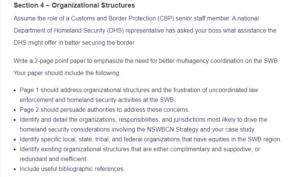Section 4-Organizational Structures
The main challenges that occur in the organizational structures interfere with communication, collaboration, and connection with other agencies in the security sector. Communication involves the management of information in terms of sharing within the team as well as disclosing it to the public. Intelligence is critical for all agencies that take part in law enforcement within the USA and at the country’s borders. Collaboration is a critical aspect in ensuring that terror threats are subdued at the border. The different security agencies require assistance from other departments to ensure that available resources are channeled towards the maintenance of security at the border. Collaboration is necessary due to the different aspects that encompass the South West border insecurity (Rudman, 2021). These issues include human and drug trafficking, the sale, and purchase of weapons, as well as money laundering. The Department of Homeland Security (DHS) cannot mitigate or eliminate all these security risks solely. The agency requires intelligence to thwart any security threats, and reinforcement from different regional officers. Hire our assignment writing services in case your assignment is devastating you.
The ability to collaborate with other security agencies allows the different stakeholders to connect with each other professionally. It also facilitates the achievement of the main objectives that are highlighted by the South West Border security project. The overwhelming security needs in the country are beyond the capacity of DHS alone. Such new security threats are constantly demanding a review of the long-standing responsibilities that different government agencies have held. The numerous assessments, which have been happening on an ad-hoc basis, lack a sense of direction and increase the country’s vulnerability to insecurity. A heightened need to involve non-security agencies such as the Department of Justice, Environmental Protection Agency, Health, and Human Services, as well as Energy is present (Homeland Security: Effective Intergovernmental Coordination is Key to Success, 2002).
The U.S. Customs and Border Protection (CBP) is responsible for ensuring that terrorists and their weapons do not penetrate the country’s border. It secures and facilitates trade as well as travel, while at the same time enforcing various regulations that govern immigration and drug trafficking. The National Gang Intelligence Center (NGIC) collects intelligence related to gangs in the country. NGIC provides support to the agencies that enforce laws by sharing intelligence in a timely manner. Highlighting the main gangs that pose a security threat to the communities is critical for security maintenance efforts.
The National Cybersecurity Communications Integration Sector (NCCIC) is responsible for providing any communication and cyber incidents that are important in the maintenance of security. NCCIC works in collaboration with DHS, the intelligence community, state governments, local governments, as well as the private sector. The National Cyber Alert System (NCAS) avails all threats and information that pose a security hazard. The Blue Campaign to Combat Human Trafficking leads the way in ensuring that the rights of all individuals are observed. It works in collaboration with DHS, which investigates claims related to human trafficking, victim protection, and arresting the traffickers (DHS, 2013). All these agencies work together to ensure that the DHS is successful in maintaining security at the South West Border. Failure to collaborate, communicate, and connect paralyzes the efforts in light of intense security threats. The need to maintain internal security in the country is critical for all agencies within the security docket and those that do not belong here. All have a collective role to play in ensuring that weapons, drugs, money, and humans are not smuggled in through the border.
References
DHS. (2013). Tribal resource Guide.
Homeland Security: Effective Intergovernmental Coordination is Key to Success. (2002).
Rudman, M. (2021). Redefining Homeland Security: A New Framework for DHS To Meet Today’s Challenges. Retrieved from Center for American Progress: https://www.americanprogress.org/issues/security/reports/2021/06/16/500642/redefining-homeland-security-new-framework-dhs-meet-todays-challenges/
ORDER A PLAGIARISM-FREE PAPER HERE
We’ll write everything from scratch
Question
Section 4 – Organizational Structures
Assume the role of a Customs and Border Protection (CBP) senior staff member. A national Department of Homeland Security (DHS) representative has asked your boss what assistance the DHS might offer in better securing the border.

Section 4-Organizational Structures
Write a 2-page point paper to emphasize the need for better multiagency coordination on the SWB. Your paper should include the following:
- Page 1 should address organizational structures and the frustration of uncoordinated law enforcement and homeland security activities at the SWB.
- Page 2 should persuade authorities to address these concerns.
- Identify and detail the organizations, responsibilities, and jurisdictions most likely to drive the homeland security considerations involving the NSWBCN Strategy and your case study.
- Identify specific local, state, tribal, and federal organizations that have equities in the SWB region.
- Identify existing organizational structures that are either complimentary and supportive, or redundant and inefficient.
- Include useful bibliographic references.

